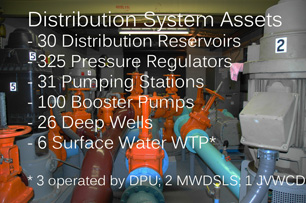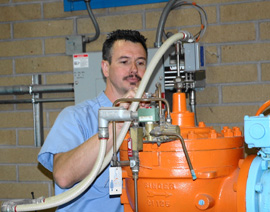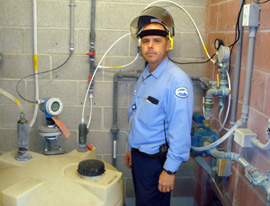Salt Lake City Water Distribution Operations
Public Utilities Operators meet challenges of operating one of the most complicated water distribution systems.
LeRoy W. Hooton, Jr.
May 27, 2008
|
The system's complexity has evolved since the first municipal pipe was installed 132 years ago to convey water from City Creek to the city's business district to now serve municipal water to over 92,000 connections within a 138 square mile service area in Salt Lake City and County.
The system has 50 pressure zones requiring 325 pressure regulators to manage water flow through an elevation change of approximately 1,600 feet. Combine this with seasonal demand variation of approximately 1:4 from average daily demand to the summer peak-day demand, along with multiple sources of supply, makes the system extremely difficult to operate.
Included in the sources of water supply are surface water and ground water supplies owned by DPU and purchased water from the Metropolitan Water District of Salt Lake & Sandy (MWDSLS). DPU owns 26 deep wells, which are mostly operated during the summer high demand months, and three water treatment plants at City Creek, Parley's and Big Cottonwood canyons. MWDSLS imports water from the Provo River Project and the Central Utah Project and treats DPU's Little Cottonwood creek water at its Little Cottonwood WTP, which is then delivered into DPU's distribution system through the Little Cottonwood Conduit and Salt Lake Aqueduct (SLA) along the east side of the valley. MWDSLS water is also treated at the Jordan Valley WTP located in Buffdale and delivered to the west side of the valley through the Jordan Aqueduct (JA). Last year the new MWDSLS Point of the Mountain WTP and Aqueduct were put into service. The treated water from this plant can be delivered either into the SLA or JA.
Operating the distribution system is accomplished with 16 employees, including the division head, supervision and operators, who all hold Grade 4 System Operator Certificates. Besides operating the system, they conduct system sanitary surveys; respond to customer low pressure and water quality complaints; and flush the system annually, to mention just a few of their many duties. Also within the operations division are 4 valve running crews and 3 facilities maintenance employees.
DPU Director Jeff Niermeyer says that he is always impressed with the distribution operators knowledge of the system and their ability to make system adjustments to keep customers in water during high demand and emergency events. The operators have an intuitive sense of how this very complex system behaves and can anticipate supply problems and make the required system adjustments. Salt Lake City water customers are fortunate to have such a dedicated and skilled group of operators.
“Electrical, pump repair and maintenance, telemetry, GIS and engineering services are supplied by supporting work divisions. These work groups are indispensable to the successful operation of the distribution system and its appurtenances,” says Water Systems Operations and Maintenance Manger Bob Wallin.
|
Customers have been asked not to water outdoors from 10:00 am to 6:00 pm, when much of the water is evaporated by the heat of the day. This has shifted the historic outdoor water demand from day time to night hours. Where the distribution reservoirs recovered during the night-hours, the reservoirs now recover during the day-hours when outdoor watering is curtailed. Besides shifting the demand, it has also reduced the daily peak demand during the summer months. Before the conservation change the peak day demand was 225 mgd and now has been reduced below 200.
Water Operations Supervisor Dennis Holland enjoys the challenges of operating DPU's complex distribution system. “It's a challenging job with something different every day – that makes the job so interesting,” he says. Adding, “I enjoy the problem-solving aspect of the work.” Currently, two new high elevation zones are being integrated into the system. Water service to the Tavaci Subdivision at the mouth of Big Cottonwood Canyon and Granite Oaks Subdivision at the mouth of Little Cottonwood Canyon will begin this spring, making 50 separate pressure zones. Both of these developments will be pumped systems with new distribution reservoirs.
In regards to the distribution team, Holland says he's fully confident of their ability to operate the system. “The operators are very sharp – they know how to handle the system operations and keep water flowing to our customers,” says Holland.
Holland says that because of the complexity of the system, it is necessary for distribution operators to be involved in large fires and maintenance and new construction shutdowns. On any given street you could have watermains that are in different zones, and it is necessary to make sure which main is being tapped into or used to suppress a large fire.
|
Looking to the future, water distribution will continue to change and most likely will become even more complex. Envision Utah predicts that the population will more than double along the Wasatch Front in the coming years. This will increase building and population densities in existing cities. Salt Lake City will join other major U.S. cities by growing upward and outward. As the capitol, the City will continue to service an increasing number of nonresident workers and visitors.
Over the past years there has been a continuum of more stringent federal and state regulations governing drinking water supply and distribution. There has been growing emphasis on the quality of water in the distribution system after it leaves the treatment plants. Certainly, more stringent standards will be promulgated in the future increasing security, backflow prevention, water quality and fire flow requirements. When asked, Wallin averred, “The bar just keeps getting higher and higher.”


